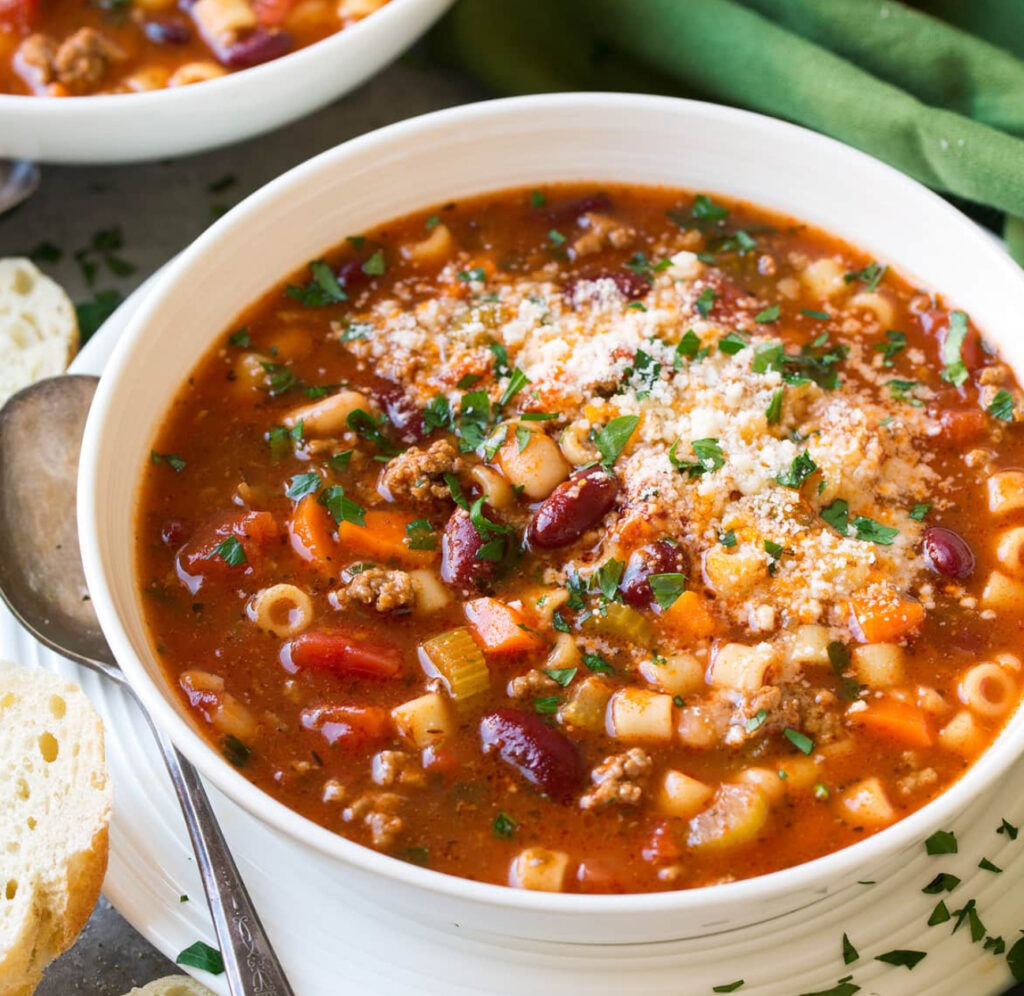
Pasta Fagioli, often pronounced “pasta fazool” in Italian-American communities, is a quintessential Italian comfort food. Translating to “pasta and beans,” this humble dish originated as a peasant meal, crafted from inexpensive, accessible ingredients. Over time, it has evolved into a beloved staple of Italian cuisine, celebrated for its simplicity, heartiness, and versatility.
In this detailed guide, we’ll explore the origins of Pasta Fagioli, its traditional preparation, variations, and tips for making the perfect pot of this classic dish. Whether you’re new to Italian cooking or revisiting a family favorite, this recipe is sure to bring warmth and satisfaction to your table.
A Brief History of Pasta Fagioli
Pasta Fagioli traces its roots to Italy’s cucina povera, or “poor kitchen”—a culinary tradition focused on creating delicious meals from simple, affordable ingredients. The dish was particularly popular in rural regions where beans, pasta, and seasonal vegetables were dietary staples. While its exact origins are difficult to pinpoint, Pasta Fagioli is most commonly associated with southern Italy.
Over the years, the recipe has traveled across oceans and generations, adapting to local ingredients and tastes. In the United States, Italian immigrants popularized a version that often incorporates tomato sauce or broth, giving it the rich, comforting flavor profile we recognize today.
Traditional Ingredients
The beauty of Pasta Fagioli lies in its adaptability, but certain ingredients remain consistent in most versions of the dish:
1.Pasta: Small shapes like ditalini, elbow macaroni, or small shells are traditionally used.
2.Beans: Cannellini or borlotti beans (also known as cranberry beans) are the classic choice, often canned or cooked from dried.
3.Aromatics: Onions, garlic, celery, and carrots form the flavor base.
4.Herbs: Fresh or dried rosemary, thyme, or oregano are common, along with a bay leaf.
5.Tomatoes: Many versions include canned crushed tomatoes, tomato sauce, or fresh tomatoes for added depth.
6.Broth: Vegetable, chicken, or beef broth serves as the liquid base.
7.Olive Oil: Extra virgin olive oil adds richness and authenticity.
8.Cheese: Parmesan or Pecorino Romano is often grated on top for a salty, nutty finish.
Traditional Recipe: How to Make Pasta Fagioli
Here’s a classic recipe for Pasta Fagioli that serves 4-6 people:
Ingredients
•2 tbsp extra virgin olive oil
•1 medium onion, finely chopped
•2 garlic cloves, minced
•1 carrot, diced
•1 celery stalk, diced
•1 tsp dried oregano or thyme
•1 bay leaf
•1 (14 oz) can crushed tomatoes
•4 cups vegetable or chicken broth
•2 (14 oz) cans cannellini or borlotti beans, rinsed and drained
•1 cup small pasta (ditalini, elbows, or shells)
•Salt and pepper, to taste
•Fresh parsley, chopped (for garnish)
•Parmesan or Pecorino Romano cheese, grated (optional)
Instructions
1.Prepare the Base
In a large pot, heat the olive oil over medium heat. Add the onion, garlic, carrot, and celery. Sauté for 5-7 minutes, or until the vegetables are softened.
2.Add Herbs and Tomatoes
Stir in the oregano, bay leaf, and crushed tomatoes. Cook for 2-3 minutes, allowing the flavors to meld.
3.Simmer the Broth
Pour in the broth and beans. Bring to a boil, then reduce the heat and let it simmer for 20 minutes. Use a spoon to lightly mash some of the beans to thicken the soup.
4.Cook the Pasta
Add the pasta to the pot and cook until al dente, following the package instructions (usually 8-10 minutes). Stir occasionally to prevent sticking.
5.Season and Serve
Remove the bay leaf and season with salt and pepper to taste. Ladle into bowls, garnish with fresh parsley, and sprinkle with grated cheese if desired.
Tips for the Perfect Pasta Fagioli
1.Timing the Pasta:
For the best texture, cook the pasta directly in the soup just before serving. If making in advance, cook the pasta separately and add it when reheating.
2.Thicker or Thinner?
Adjust the consistency to your liking. For a thicker soup, mash more beans or reduce the broth. For a thinner version, add extra broth or water.
3.Protein Additions:
For a heartier meal, add Italian sausage, pancetta, or shredded chicken.
4.Gluten-Free Option:
Swap traditional pasta for gluten-free pasta or omit it altogether and increase the beans.
5.Make it Vegan:
Use vegetable broth and skip the cheese, or substitute with a plant-based alternative.
Regional Variations
Pasta Fagioli differs from region to region and even family to family. Here are a few common variations:
Northern Italy:
Recipes often include more beans and less tomato, resulting in a lighter, creamier soup. Pancetta is sometimes added for flavor.
Southern Italy:
Southern versions are heartier and more tomato-based, with bolder flavors thanks to garlic and herbs.
Italian-American Style:
This version typically includes a rich tomato broth and is often paired with crusty bread or garlic knots.
One-Pot Versions:
In some households, all ingredients are cooked together from the start, creating a thick, stew-like consistency.
How to Serve Pasta Fagioli
Pasta Fagioli is a versatile dish that can be served as an appetizer, side, or main course. Here are some serving suggestions:
With Bread:
Serve with crusty Italian bread or garlic toast for dipping.
As a Main Dish:
Pair with a light salad or roasted vegetables for a balanced meal.
In a Bread Bowl:
Hollow out a round loaf of bread and use it as an edible bowl for an extra cozy presentation.
With Wine:
Complement the dish with a glass of Chianti or another medium-bodied red wine.
Leftovers and Storage
Pasta Fagioli tastes even better the next day as the flavors deepen. However, the pasta can absorb the liquid, making it mushy. To avoid this, store the soup and pasta separately. Refrigerate leftovers in airtight containers for up to 3 days or freeze for up to 3 months. Reheat gently on the stovetop, adding broth as needed.
Impression
Pasta Fagioli is more than just a dish—it’s a celebration of comfort, tradition, and the beauty of simplicity. Whether you’re enjoying it as a quick weeknight meal or as part of a holiday feast, its hearty flavors and rich history make it a timeless favorite. With endless ways to customize and serve it, this classic Italian recipe is sure to bring warmth and satisfaction to your table. So grab your ingredients, gather your loved ones, and let Pasta Fagioli work its magic. Buon appetito!
No comments yet.








